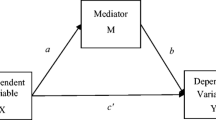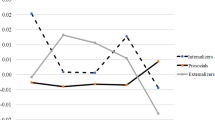Abstract
Several investigators have underlined the importance of long-term prevention programs in order to expect positive results for at-risk children. One essential prerequisite to addressing this issue is the retention of participants in such programs. The present study aims at examining the contribution of mother–child interactions, mother's social isolation, improvement in the mother–child relationship, and improvement in the child's behavior to the prediction of persistence. Participants (n = 59 disruptive boys) were recruited for a 3-year multicomponent preventive intervention program. Results indicated an improvement of the boys' behavior (reduction of inattention/hyperactivity and reduction of fighting) during the first year of the program, and showed that mother–child positive interactions before the beginning of the program were the best predictors of persistence. Implications of these results for long-term preventive programs are discussed.
Similar content being viewed by others
REFERENCES
Abidin, R. R. (1986). Parenting Stress Index (PSI) manual (2nd ed.). Charlottesville, VA: Pediatric Psychology Press.
Abikoff, H. (1985). Efficacy of cognitive training interventions in hyperactive children: A critical review. Clinical Psychology Review, 5, 479–512.
Armbruster, P., & Kazdin, A. E. (1994). Attrition in child psychotherapy. In T. H. Ollendick & R. J. Prinz (Eds.), Advances in clinical child psychology (pp. 81–108). New York: Plenum.
Armbruster, P., & Schwab-Stone, M. E. (1994). Sociodemographic characteristics of dropouts from a child guidance clinic. Hospital and Community Psychiatry, 8, 804–808.
Behar, L., & Stringfield, S. (1974). A behavior rating scale for the preschool child. Developmental Psychology, 10, 601–610.
Braswell, L., August, G. J., Bloomquist, M., Realmuto, G. M., Skare, S. S., & Crosby, R. D. (1997). School based secondary prevention for children with disruptive behavior: Initial outcomes. Journal of Abnormal Child Psychology, 25, 197–208.
Charlebois, P. (2000). La prévention des problèmes associés au déficit d'attention avec hyperactivité. In F. Vitaro & C. Gagnon (Eds.), Prévention des Problèmes d'Adaptation chez les Enfants et les Adolescents (pp. 69–113). Sainte Foy: Presses de l,Université du Québec.
Charlebois, P. (2001). A multi modal intervention to prevent academic underachievement in young disruptive boys: The Laurentians longitudinal experimental study. Paper presented at the Xth conference of the European Society Developmental Psychology, Upsalla, Sweden.
Charlebois, P., LeBlanc, M., Gagnon, C., Larivée, S., & Tremblay, R. E. (1995). Teacher, mother and peer support in the elementary school as protective factors against juvenile delinquency. International Journal of Behavioral Development, 18, 1–22.
Charlebois, P., Normandeau, S., & Vitaro, F. (1999). Skills training for inattentive, overactive, aggressive boys: Differential effects of content and delivery method. Behavioral Disorders, 24, 137–150.
Cohen, D. A., & Rice, J. C. (1995). A parent-targeted intervention for adolescent substance use prevention: Lessons learned. Evaluation Review, 19, 159–180.
Cunningham, C. E., Bremner, R., & Boyle, M. (1995). Large group community-based parenting programs for families of preschoolers at risk for disruptive behavior disorders: Utilization, cost effectiveness, and outcome. Journal of Child Psychology and Psychiatry, 36, 1141–1159.
Dahlstrom, W. G., Welsh, G. S., & Dahlstrom, L. E. (1975). An MMPI hand book: Vol. II. Research developments and applications. Minneapolis: University of Minnesota Press.
DeVito, J. A. (1993). Essentials of human communication. New York: Harper Collins College.
Dishion, T. J., Garner, K., Patterson, G. R., Reid, J. B., & Thibodeaux, S. (1983). The family process code:Amultidimentional system for observing family interaction. Unpublished technical report, Oregon Social Learning Center, Eugene, OR.
Dumas, J. E., & Whaler, R. G. (1983). Predictors of treatment outcome in parent training: Mother insularity and socioeconomic disadvantage. Behavioral Assessment, 5, 301–313.
Eddy, J. M., Dishion, T. J., & Stroomiller, J. (1998). The analysis of intervention change in children and families: Methodological and conceptual issues embedded in intervention studies. Journal of Abnormal Child Psychology, 26, 53–69.
Forehand, R., & McMahon R. J. (1981). Helping the noncompliant child:Aclinician's guide to parent training. NewYork: Guilford Press.
Hayes, R. L. (1992). Empowering organizations: A facilitating role of counselors in restructuring schools. Athens, GA: University of Georgia.
Kazdin, A. E. (1996a). Combined and multimodal treatments in child and adolescent psychotherapy: Issues, challenges, and research directions. Clinical Psychology Science and Practice, 3, 69–100.
Kazdin, A. E. (1996b). Dropping out of child psychotherapy: Issues for research and practice. Clinical Child Psychology and Psychiatry, 1, 133–156.
Kazdin, A. E., & Mazurick, J. L. (1994). Dropping out of child psychotherapy: Distinguishing early and late dropouts over the course of treatment. Journal of Consulting Clinical Psychology, 5, 1069–1074.
Kazdin, A. E., Mazurick, J. L., & Bass, D. (1993). Risk for attrition in treatment of antisocial children and families. Journal of Clinical Child Psychology, 1, 2–16.
Kazdin, A. E., Stolar, M. J., & Marciano, P. L. (1995). Risk factors for dropping out of treatment among white and black families. Journal of Family Psychology, 9, 402–417.
Kazdin, A. E., & Wassell, G. (1998). Treatment completion and therapeutic change among children referred. Professional Psychology: Research and Practice, 4, 332–340.
Kazdin, A. E., & Wassell, G. (1999). Barriers to treatment participation and therapeutic change among children referred for conduct disorder. Journal of Clinical Child Psychology, 28, 160–172.
Kupersmidt, J. B., Coie, J. D., & Dodge, K. A. (1990). The role of peer relationships in the development of conduct disorder. In S. R. Asher & J. D. Coie (Eds.), Peer rejection in childhood (pp. 274–308). New York: Cambridge University Press.
Lochman, J. E. (1985). Effects of different treatment lengths in cognitive behavioral intervention with aggressive boys. Child Psychiatry and Human Development, 116, 45–56.
Martin, P. P. (1988). Assessment of personality and behavior problems: Infancy through adolescence. New York: Guilford Press.
Mash, E. J. (1999). Treatment of child and family disturbance: A behavioral-systems perspective. In E. J. Mash & R.A. Barkley (Eds.), Treatment of childhood disorders (2nd ed., pp. 3–51). New York: Guilford Press.
Mash, E. J., & Terdal, L.G. (Eds.). (1997). Assessment of childhood disorders (3rd ed.). New York: Guilford Press.
McGraw, S. A., McClements, L., Lasater, T. M., Assaf, A. L., & Carleton, R. A. (1989). Methods in program evaluation: The process evaluation system of the Pawtucket health program. Evaluation Review, 13, 459–483.
McGraw, S. A., Stone, E. J., Osfanian, S. K., Elder, J. P., Perry, C. L., Johnson, C. C., Parcel, G. S., Webber, L. S., & Luepker, R. V. (1994). Design of process evaluation within the child and adolescent trial for cardiovascular health (CATCH). Health Education Quaterly (Suppl. 2), 5–26.
Normand, C. L., Vitaro, F., & Charlebois, P. (2000). Comment améliorer la participation et réduire l'attrition des participants aux programmes de prévention. In F. Vitaro & C. Gagnon (Eds.), Prévention des problèmes d'adaptation chez les enfants et les adolescents (Tome 1, pp. 100–133). Sainte Foy: Presses Universitaires du Québec.
Papert, K. D. (1972). Teaching children thinking. Programmed Learning and Educational Technology, 9, 245–255.
Patterson, G. R., & Forgatch, M. S. (1995). Predicting future clinical adjustment from treatment outcome and process variables. Psychological Assessment, 7, 275–285.
Pekarik, G. (1992). Post-treatment adjustment of clients who drop out early vs. late in treatment. Journal of Clinical Psychology, 3, 379–387.
Pekarik, E.G., Prinz, R. J., & Liebert, D. E. (1974). The Pupil Evaluation Inventory: A sociometric technique for assessing children's social behavior. Journal of Abnormal Child Psychology, 4,83–97.
Prifitera, A., & Dersh, J. (1993). Base rates of WISC-III diagnostic subtest patterns among normal, learning disabled, and ADHD samples. Journal of Psychoeducational Assessment. Monograph Series: Advances in Psychoeducational Assessment, Weschler Intelligence Scale for Children (3rd ed.), 43–55.
Schneider, B.H. (1992). Didactic methods for enhancing children's peer relations: A quantitative review. Child Psychology Review, 12, 363–382.
Schwartzman, A. E., Ledingham, J. E., & Serbin, L. A. (1985). Identification of children at risk for adult schizophrenia: A longitudinal study. International Review of Applied Psychology, 34, 363–380.
Tremblay, R. E., Desmarais-Gervais, L., Gagnon, C., & Charlebois, P. (1987). The Preschool Behavior Questionnaire: Stability of its factor structure between cultures, sexes, ages, and socioeconomic classes. International Journal of Behavioral Development, 10, 467–484.
Tremblay, R. E., LeMarquand, D., & Vitaro, F. (1999). The prevention of oppositional defiant and conduct disorder. In H. C. Quay & A. E. Hogan (Eds.), Handbook of disruptive behavior disorders (pp. 525–555). New York: Kluwer Academic/Plenum.
Weinstein, R. S., Soulé, C. R., Collins, R. C., Cone, J., Mehlhorn, M., & Simontacchi, K. (1991). Expectations and high-school change: Teacher–researcher collaboration to prevent school failure. American Journal of Community Psychology, 19, 333–363.
Weir, U., & Duveen, G. (1986). Further development and validation of the prosocial behavior questionnaire for the use by teacher. Journal of Child Psychology and Psychiatry, 22, 357–374.
Weschler, D. (1991a). Manual for the Weschler Children Intelligence Scale-Revised. San Antonio, TX: The Psychological Corporation.
Weschler, D. (1991b). Manual for the Weschler Adult Intelligence Scale-Revised. San Antonio, TX: The Psychological Corporation.
Wierzbicki, M., & Pekarik, G. (1993). A meta-analysis of psychotherapy dropout. Professional Psychology: Research and Practice, 24, 190–195.
Yokishaswa, H. (1994). Prevention as cumulative protection: Effects of early family support and education on chronic delinquency and its risks. Psychological Bulletin, 115, 28–54.
Author information
Authors and Affiliations
Rights and permissions
About this article
Cite this article
Charlebois, P., Vitaro, F., Normandeau, S. et al. Predictors of Persistence in a Longitudinal Preventive Intervention Program for Young Disruptive Boys. Prev Sci 2, 133–143 (2001). https://doi.org/10.1023/A:1011537922991
Issue Date:
DOI: https://doi.org/10.1023/A:1011537922991




